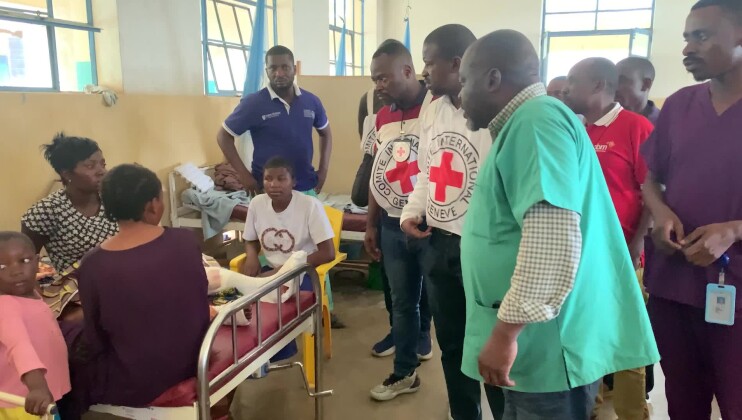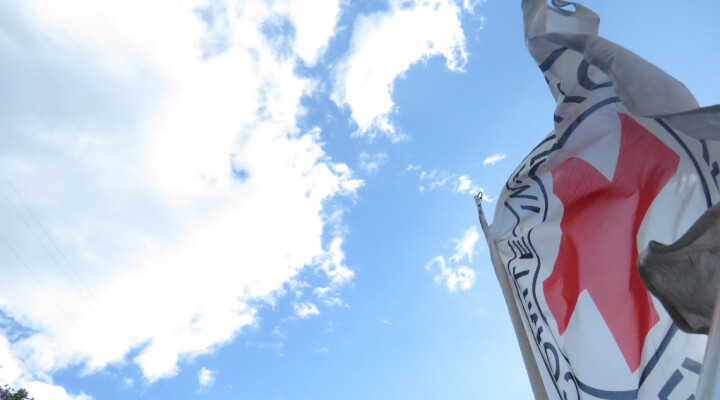DRC: the influx of civilians wounded by heavy weapons overwhelms hospitals in the kivus
In February 2024, the Ndosho hospital in Goma, in the east of the DRC, received six times more patients than usual, forcing it to double its capacity and transfer patients to the provincial hospital in Bukavu. Forty per cent of these patients were victims of heavy artillery used in urban areas, including near camps for displaced people on the outskirts of Goma. This is a sign of a new turning point in the conflict in the DRC, according to the International Committee of the Red Cross (ICRC) teams on the ground.
"I saw a baby who had been hit in the abdomen by shrapnel, a baby who was barely nine months old. It raises questions about the humanity that must prevail in armed conflicts, and it gives a very brief overview of the humanitarian disaster that is afflicting the east of the DRC today," said Robert Mardini, the ICRC's director-general, during a five-day visit to the country.
The wounded are pouring into medical facilities, which are often deserted by medical staff who had to flee the fighting. Hospitals are desperately short of equipment and the remaining staff are forced to evacuate patients to other towns, particularly Goma. The ICRC is transporting the wounded by boat to Bukavu to relieve the Ndosho hospital.
Between 1 October 2023 and 29 February 2024, 112 people injured in clashes were transferred from the Ndosho hospital in Goma to the Bukavu provincial hospital, a facility also supported by the ICRC.
"In 2023, we had 60 patients a month. But since 2024, we have seen a spectacular increase in the number of patients. In February alone, we received 342 cases, which is six times more than in a normal situation," explained Roger Mburano, the ICRC's surgical project manager at Ndosho Hospital.
The injuries recorded by the medical staff are varied and multiple. "There are abdominal injuries, there are chest injuries, there are head injuries, there are upper and lower limb injuries," continued Roger Mburano. "We receive people injured by weapons and bomb explosions, as well as stab wounds," he concluded.
The ICRC has been supporting the Ndosho hospital in Goma since November 2012. Never before had the centre faced such an outbreak of violence, forcing the ICRC to increase its capacity from two to three surgical teams. This is in addition to the measures already taken, which include donations of equipment and medicines, staff training, financial aid, and the rehabilitation and fitting-out of various buildings. Since 2013, support has also been provided to the Bukavu provincial hospital, where the ICRC has opened a training centre for war surgery.
LOG LIST
Location: Goma and Bukavu, DRC
Camera: Jonathan Busasi, Joseph Nkoy
Filming Date: 29th February 2024
Length: 06:41
Copyright: ICRC access all
On Screen Credit: ICRC written or logo attached to story
00:00 – 00:45: Various shots of patients being evacuated from Goma’s Ndosho hospital.
00:46 - 00:55: Shot of a family member talking to a patient.
00:56 – 01:07: Various shots of ICRC vehicles transporting the patients to an awaiting boat for onward transportation to Bukavu.
01:08 – 01:14: Shot of patients in the ICRC vehicle.
01:15 – 02:04: Soundbite: Roger Mburano – Project Administrator, Goma hospital - ICRC
"In 2023, we had 60 patients a month. But since 2024, we have seen a spectacular increase in the number of patients. In February alone, we received 342 cases, which is six times more than in a normal situation. There are abdominal injuries, there are chest injuries, there are head injuries, there are upper and lower limb injuries. We receive people injured by weapons and bomb explosions, as well as stab wounds"
02:05 – 03:18: Various shots of patients being moved to an ICRC boat for onward transportation to Bukavu.
03:19 – 04:02: Various shots of the ICRC boat transporting patients to Bukavu.
04:03 – 04:20: Various shots of the ICRC boat arriving in Bukavu.
04:21 – 04:53: Shots of the patients being transferred from the boat to ICRC vehicles.
04:54 – 05:18: Soundbite: Zongo Lassane, head of ICRCHospital project, Bukavu
“So the overflow from Goma hospital was transferred to Bukavu hospital. There we had a little more capacity to deal with those injured in the ongoing conflict in North Kivu. As of today, we have more than 100 patients transferred from Goma.”
05:19 – 05:45: Shots of ICRC vehicles transporting the patients from the boat to Bukavu hospital.
05:46 – 06:41: Various shots of patients being moved into the ward at Bukavu hospital.
06 :42 – 07 :23: Audio: Robert Mardini, ICRC Director General
"I saw a baby who had been hit in the abdomen by shrapnel, a baby who was barely 9 months old. It raises questions about the humanity that must prevail in armed conflicts, and it gives a very brief overview of the humanitarian disaster that is afflicting the east of the DRC today. There is one very effective way of reducing human suffering, and that is for the parties to the conflict to respect their obligations under international humanitarian law, and today the ICRC is urging them to honor their obligations under the rules of war.”
Ends
For further information, please contact:
Fatima Sator, ICRC Geneva, +41 22 730 3443, press@icrc.org
Nagham Awada, ICRC Goma, +243 812256360, nawada@icrc.org
Eléonore Asomani, ICRC Dakar, +221 781864687 easomani@icrc.org



